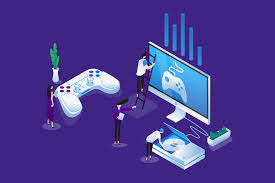Game Design involves conceptualizing and creating the mechanics, rules, and content of a game. It encompasses everything from the initial idea to the final product, requiring a deep understanding of player behavior, narrative structure, and technical execution. Game designers work collaboratively with artists, programmers, and sound designers to bring their visions to life.
Key Areas of Game Design
- Gameplay Mechanics: This refers to the rules and systems that dictate how a game functions. Designers must consider how players will interact with the game, what actions are possible, and how those actions impact the game world.
- Level Design: Level designers create the environments in which players navigate and complete challenges. This involves not only the layout of the space but also the placement of obstacles, enemies, and rewards.
- Storytelling: Narrative design is crucial for games that rely on story-driven experiences. Designers develop characters, plotlines, and dialogues that immerse players in the game’s world, often employing techniques borrowed from literature and film.
- Visual Design: Art direction plays a significant role in the overall feel of a game. Game designers work closely with artists to define the visual style, ensuring that it complements the gameplay and narrative.
- User Interface (UI) and User Experience (UX): A well-designed UI helps players understand how to navigate and interact with the game. UX design focuses on ensuring that players have a seamless and enjoyable experience.
The Game Design Process
The game design process can vary significantly depending on the size of the team and the scope of the project, but it generally includes the following phases:
- Concept Development: This initial phase involves brainstorming ideas and defining the core concept of the game. Designers consider the target audience, genre, and unique selling points.
- Prototyping: Early prototypes are created to test gameplay mechanics and concepts. This stage is crucial for identifying what works and what doesn’t, allowing designers to iterate quickly.
- Production: Once the design is solidified, the production phase begins. This involves the detailed development of game assets, coding, and integrating art and sound.
- Testing: Playtesting is essential to gather feedback on gameplay, balance, and overall experience. Designers use this feedback to make adjustments and improvements.
- Launch and Post-Launch: After the game is released, designers often continue to support it with updates, expansions, and bug fixes based on player feedback.
The Role of Technology in Game Design
Advancements in technology have profoundly influenced game design. Modern tools and engines like Unity and Unreal Engine provide designers with powerful resources to create immersive worlds and complex interactions. Emerging technologies such as virtual reality (VR) and augmented reality (AR) are opening new avenues for game experiences, challenging designers to rethink traditional gameplay mechanics and storytelling methods.
The Future of Game Design
The future of game design holds exciting possibilities as the industry continues to grow and evolve. Key trends include:
- Increased Accessibility: Designers are focusing on creating games that are accessible to a broader audience, including those with disabilities. This includes implementing customizable controls, subtitles, and visual aids.
- Emphasis on Diversity: As the gaming community becomes more diverse, there is a growing demand for games that reflect a wide range of cultures, stories, and experiences.
- Community Engagement: Many developers are involving players in the design process through beta testing and community feedback, leading to more collaborative and responsive game development.
- Indie Game Development: The rise of independent game development has led to a surge in innovative and unique games that challenge conventional design norms. Indie studios are pushing creative boundaries and exploring niche markets.
Conclusion
Game design is a dynamic and rapidly evolving field that combines artistry, technology, and storytelling. As the industry continues to grow, the role of game designers will be crucial in shaping the future of interactive entertainment. Whether through innovative mechanics, compelling narratives, or stunning visuals, game designers have the power to create experiences that resonate with players and push the boundaries of what games can achieve. As technology advances and the gaming community diversifies, the possibilities for game design are endless, promising a bright future for the industry.




